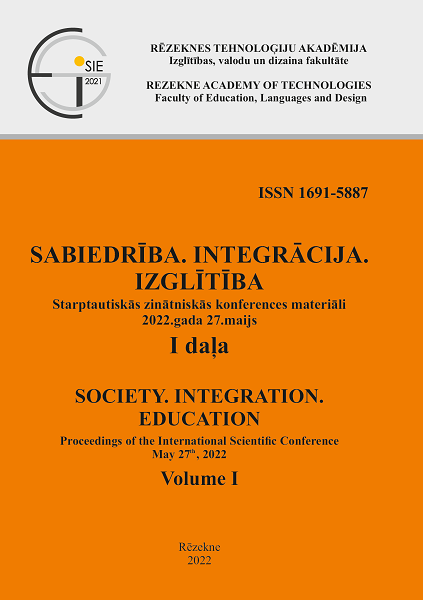SCHOOLS AS INFORMATION CHANNEL TO REDUCE ALCOHOL USAGE HABITS AMONG ADOLESCENTS
DOI:
https://doi.org/10.17770/sie2022vol1.6869Keywords:
adolescent alcohol consumption, information channel, knowledge and self-confidence, schoolAbstract
The purchase of alcohol and the use of such substances among adolescence is prohibited in Latvia by the legal system of rights. Despite the legal ban alcohol consumption is widespread among Latvian adolescence and starts at very early age. Recent studies show that most of 15-year-olds have consumed alcohol in Latvia. In order to proactively inform and reduce alcohol consumption among young people, a number of information and education programmes have been implemented, mainly in the school environment. Most of these programmes lack an assessment. Consequently, there is a lack of data on the programme effectivity and the link of programme with young people’s knowledge and confidence in their alcohol consumption-related behaviour. The purpose of the study is to identify information channels where adolescence are most frequently gain information, to assess the level of knowledge of grade 9 pupils and its relevance to potential action in alcohol consumption situations. The empirical data of this study is based on a survey with grade 9 pupils. The results of the study show that the school environment is important information channel, but it is essential to offer a diverse information content, involving a number of experts to provide information. High levels of knowledge have a positive impact on young people’s confidence in alcohol consumption-related situations, but do not have a significant impact on alcohol trying rates.
References
Adolfsen, F., Strom, H. K., Martinussen, M., Handegard, B.H., Natvig, H., Eisemann, M., & Koposov, R. (2017). Parent participation in alcohol prevention: Evaluation of an alcohol prevention programme. Nordic Studies on Alcohol and Drugs, 34(6), 456–470. DOI: https://doi.org/10.1177/1455072517732276
Alcohol Education Trust. (2015). Program: Talk about alcohol. Retrieved from https://www.talkaboutalcohol.com/
Animosa, L.H., Johnson, S.L. & Cheng, T.L. (2015). “I Used to Be Wild”: Adolescent Perspectives on the Influence of Family, Peers, School, and Neighborhood on Positive Behavioral Transition. Youth & Society. 1–26.
DOI: https://doi.org/10.1177/0044118X15586146
Baker, K. (2014). Underage drinking. No (sast. Craig), Defining Deviance. Encyclopedia of Social Deviance vol.2 (761 -764). USA: Sage Publications.
Brauer, J. R., & De Coster, S. (2015). Social Relationships and Delinquency: Revisiting Parent and Peer Influence During Adolescence. Youth & Society 47(3), 374–394. DOI: https://doi.org/10.1177/0044118X12467655
Dave, D., Corman, H., Kalil, A., Schwartz-Soicher, O., & Reichman, N.E. (2021). Integrational effects of welfare reform: Adolescent delinquent and risky behaviours. Economic Inquiry 59(1), 199–216. DOI: 10.1111/ecin.12931
Dudovitz, R.N., Chung, P.J., & Wong M.D. (2017). Teachers and Coaches in Adolescent Social Networks Are Associated with Healthier Self-Concept and Decreased Substance Use. Journal of School Health, 87(1), 12-20. DOI: https://doi.org/ 10.1111/josh.12462
Eiropas Narkotiku un narkomānijas uzraudzības centrs. (2019). Eiropas profilakses programma (68-69) Pieejams:
https://www.spkc.gov.lv/sites/spkc/files/media_file/eiropas-atkaribu-profilakses-rokasgramata.pdf
European School Survey Project on Alcohol and Other Drugs. (2015). The 2015 ESPAD report. Retrieved from http://espad.org/report/home
Horvath, Z., Qirjako, G., Pavlova, D., Taut, D., Vaičiūnas, T., Melkumova, M., Varnai, D., Vieno, A., Demetrovics, Z., Urban, R., & Nemeth, A. (2021). The information capacity of adolescent alcohol consumption indicators along a continuum of severity: A cross-national comparison of sixteen Central and Eastern European countries. Alcoholism, Clinical & Experimental research, 45:1840–1852.
DOI: https://doi.org/ 10.1111/acer.14679
Hurley, E., Dietrich, T., & Rundle-Thiele, S. (2019). A systematic review of parent based programs to prevent or reduce alcohol consumption in adolescents. Hurley et al. BMC Public Health, 19:1451. DOI: https://doi.org/10.1186/s12889-019-7733-x
Kristjansson, A.L., Mann, M.J., Sigfusson, J., Thorisdottir, I.E., Allegrante, J.P., & Sigfusdottir, I.D. (2020). Development and Guiding Principles of the Icelandic Model for Preventing Adolescent Substance Use. Health Promotion Practice 21(1), 62–69. DOI: https://doi.org/10.1177/1524839919849032
LR Kultūras Ministrija. (2017). Pētījums par 9 līdz 16 gadus vecu bērnu un pusaudžu medijpratību Latvijā. 12. Pieejams:
LR Saeima. (2004). Alkoholisko dzērienu aprites likums. 6. pans 2. punkts. Rīga: LR Saeima. Pieejams: https://likumi.lv/ta/id/88009-alkoholisko-dzerienu-aprites-likums
LR Veselības ministrija & SPKC. (2015). Informatīvā kampaņa: Lai būtu skaidrs. Pieejams: https://www.skaidrs.lv/
Lynch, S., Styles, B., Dawson, A., Worth, J., Kerr, D., & Lloyd, J. (2013). Talk About Alcohol: an Evaluation of the Alcohol Education Trust’s Intervention in Secondary Schools. Slough: NFER., 120 – 136. Retrieved from:
https://www.nfer.ac.uk/publications/aete01/aete01.pdf
Martinovic, I., Un Kim, S., & Stanarevic Katavic, S. (2021). Study of health information needs among adolescents in Croatia shows distinct gender differences in information seeking behaviour. Health Information and Libraries Journal 00:1–22. DOI: https://doi.org/10.1111/hir.12369
Organisation for Economic Co-operation and Development. (2020). Health at a Glance. DOI: https://doi.org/10.1787/19991312
Shafiee, S., Razaghi, E., & Vedadhir, A. (2019). Multi-level approach to theories of addiction: A critical review, Iranian Journal of Psychiatry and Behavioral Sciences 13(2). DOI: https://doi.org/10.5812/ijpbs.88881
Slimību profilakses un kontroles centrs. (2017). Atkarību izraisošo vielu profilakse Latvijā 2017. gadā. Pētījuma gala ziņojums. 32 – 37. Pieejams:
www.spkc.gov.lv/lv/zinojumi/atkaribu-izraisoso-vielu-profilakse-latvija-2017.-gada-gala-zinojums.pdf
Slimību profilakses un kontroles centrs. (2020). Latvijas skolēnu veselības paradumu pētījums. 2017./2018. mācību gada aptaujas rezultāti un tendences. Pieejams: https://www.spkc.gov.lv/sites/spkc/files/data_content/latvijas-skolenu-veselibas-paradumu-petijums-05.10.2020_1.pdf
Sobkin, V.S., Abrosimova, Z. B., Adamchuk, D.V., & Baranova E.V. (2005). Manifestations of Deviation in the Adolescent Subculture. Russian Education and Society, 47(7), 49-71. Retrieved from https://eric.ed.gov/?id=EJ748625
Rīgas domes Labklājības departaments. (2010). Riska un aizsargājošo faktoru ietekme un atkarību izraisošo vielu lietošanu jauniešu vidū. Pētījuma 3. posms. 22. Pieejams:
https://www.veseligsridzinieks.lv/wp-content/uploads/2015/01/LD_petijums_2010_kopsavilkums.pdf
Tengstrom, A., (2018). Report: the overall results from the longitudinal study evaluating the effectiveness of the program “Prata om Alkohol”. Stocholm. Retrieved from https://drinksinitiatives.eu/storage/files/x7CQ0qLn32pxH1c8fM9Sq4IJv1rIYRCWQLB5xU0E.pdf
Ven, T.V., (2004). The community construction of the underage drinker. Deviant Behavior, 26(1), 63-83. DOI: https://doi.org/10.1080/01639620590518951
Vigna-Taglianti, F.D., Galanti, M.R., Burkhart, G., Caria, M.P., Vadrucci, S., & Faggiano, F. (2014). “Unplugged,” a European school-based program for substance use prevention among adolescents: Overview of results from the EU-Dap trial. New Directions for Youth Development 141, 67-82. DOI: https://doi.org/10.1002/yd.20087






